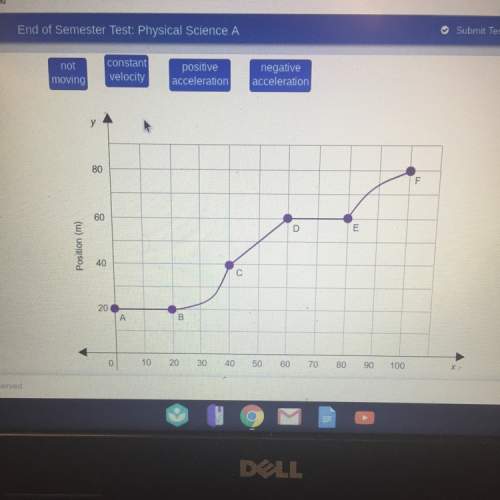
Physics, 15.01.2021 18:40, raquelwilliams5795
a drum is struck, producing a wave with a wavelength of 11000m and a speed of 2.42×10^4 m/s. what is the frequency of the wave?freq=speed/wavelength. A. 3.76*10^-9 Hz. B. 2.66*10^8 Hz. C. 0.45 Hz. D. 2.2 Hz

Answers: 1
Other questions on the subject: Physics

Physics, 22.06.2019 01:00, yedida
What is the relationship between atmospheric pressure and the density of gas particles in an area of increasing pressure? (2 points) as air pressure in an area increases, the density of the gas particles in that area decreases. as air pressure in an area increases, the density of the gas particles in that area increases. as air pressure in an area increases, the density of the gas particles in that area remains constant. as air pressure in an area increases, the density of the gas particles in that area increases and decreases in an alternating pattern. 3. which of the following correctly describes a way in which earth's atmosphere interacts with the geosphere? (2 points) it contains gases that living organisms breathe. it contains gases that trap incoming solar radiation. it provides a medium for cycles that provide nutrients to living organisms. it provides a medium for water to move between earth's surface and the air. 4. which of the following is considered a drawback to using wind energy as a source of power? (2 points) wind energy is nonrenewable. wind energy produces large amounts of air pollution. wind turbines can kill birds that fly through the rotors. wind turbines are built too close to major population centers. 5. a meteorologist predicts that the weather in a region will soon change from clear skies to probable thunderstorms. prior to making this prediction, what did the meteorologist most likely observe on a barometer? (2 points) the barometer fell slightly. the barometer fell substantially. the barometer rose slightly. the barometer rose substantially. 6. which of the following do meteorologists not typically use weather balloons to record? (2 points) atmospheric pressure cloud types humidity temperature 7. during which step in the can crush lab did water vapor force air from the can? (2 points) the can was filled nearly to the top with water. the can was placed on the hot stove top burner for several minutes. the can was removed from the hot stove top burner. the can was placed upside-down in the water-filled pan.
Answers: 3

Physics, 22.06.2019 01:30, chloe1107
Which explanation describes the forces involved for a person to walk down the sidewalk? a. the person's feet push backward on the sidewalk; the sidewalk pushes backward on the person. b. the person's feet push forward on the sidewalk; the sidewalk does not push on the person. c. the person's feet push backward on the sidewalk; the sidewalk pushes forward on the person. d. the person's feet push forward on the sidewalk; the sidewalk pushes forward on the person.
Answers: 1

Physics, 22.06.2019 11:40, johanperezpere51
Imagine that you have two balloons (or, better yet, actually inflate two balloons, if possible). create static electricity around one of the balloons by rubbing it against your hair or your sweater and then bring that balloon close to the other balloon, which has not been charged. try this with at least one other object—and for variety in the discussion, avoid using an object already described by your classmates. then, for your initial post to the discussion, answer the following questions: what happened with the two balloons?
Answers: 3

Physics, 22.06.2019 12:20, zenaidazurita1p6bs1d
Electric field of the earth. the earth has a net electric charge that causes a field at points near its surface equal to 150 n> c and directed in toward the center of the earth. (a) what magnitude and sign of charge would a 60-kg human have to acquire to overcome his or her weight by the force exerted by the earth’s electric field? (b) what would be the force of repulsion between two people each with the charge calculated in part (a) and separated by a distance of 100 m? is use of the earth’s electric field a feasible means of flight? why or why not?
Answers: 2
Do you know the correct answer?
a drum is struck, producing a wave with a wavelength of 11000m and a speed of 2.42×10^4 m/s. what is...
Questions in other subjects:

Arts, 07.10.2019 10:10


Biology, 07.10.2019 10:10

English, 07.10.2019 10:10






Mathematics, 07.10.2019 10:10







